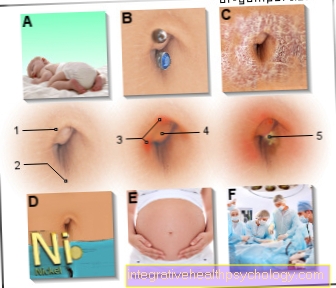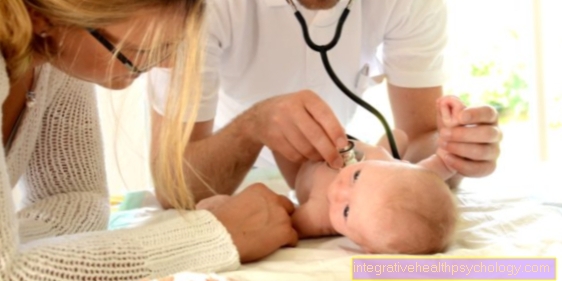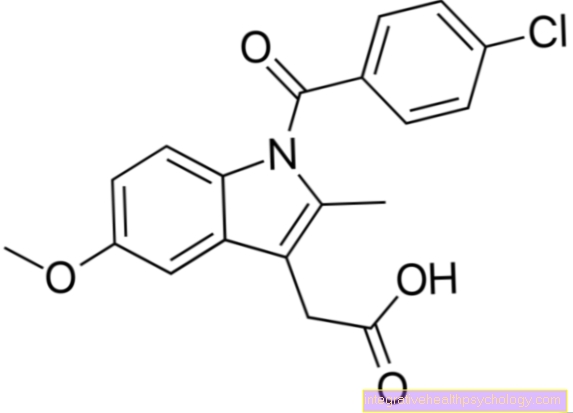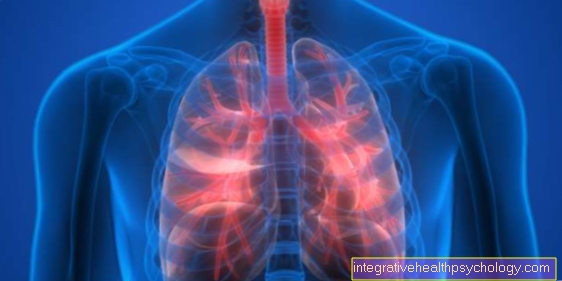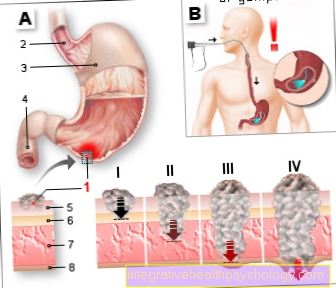Compartment syndrome (log syndrome)
definition
In many places in our body, our muscles and nerves are located in so-called muscle boxes, a compartment in which they are separated from their surroundings by a tissue skin. We have most of the muscle compartments in our extremities, i.e. the arms and legs. Their main purpose is to enable the muscles to function smoothly.
In the case of a compartment syndrome, there is increased tissue pressure in a closed skin or soft tissue covering of one or more muscle boxes, which leads to restrictions in the muscles and nerves located therein.
.jpg)
Forms of compartment syndrome
The compartment syndrome can occur in an acute or chronic form. The lower leg is most commonly affected in both forms.
- 1. Acute Compartment Syndrome: Acute Compartment Syndrome occurs as a result of a traumatic injury, such as a car accident or a broken bone. The injury causes increased tissue pressure in the affected compartment and thus leads to a reduced and insufficient blood supply to the muscles and nerves. Acute compartment syndromes are medical emergencies that must be corrected surgically as quickly as possible. If left untreated, the compartment syndrome leads to permanent damage to the muscles and nerves due to the lack of blood supply. In severe cases, the entire extremity can lose its function.
- 2. Chronic compartment syndrome: The chronic compartment syndrome (also called stress compartment syndrome or stress-induced compartment syndrome) is a clinical picture induced by muscle training, whereby the strong enlargement of the muscles during training leads to greatly increased pressures within the compartment. The pressure created by the muscles reduces the flow of blood to the affected area, which leads to a lack of oxygen in the muscles.
Emergence
For a compartment syndrome to develop, the affected muscle compartment must be intact and functional.
Development of an acute compartment syndrome:
The membranes of tissue that surround the muscles in the compartments are not stretchable. Therefore, an increased amount of fluid leads to a strong increase in pressure in the entire compartment and thus on muscles and nerves. If, as a result of a trauma, such as a broken bone, an impact trauma (bumper) or crush injuries, the pressure in the compartment increases, caused by bleeding, decreased venous return or the supplying blood, a compartment syndrome can develop.
Bandages that are too tightly applied or the closure of a connective tissue defect can constrict a compartment and cause a compartment syndrome if this creates an increase in pressure in the tissue.
Development of a chronic compartment syndrome
The chronic compartment syndrome is not preceded by any external injury, it is an exercise-induced syndrome. The basic mechanism here is the same as in the acute compartment syndrome, namely the compression of the blood vessels supplying the muscles and nerves caused by pressure.
In the case of chronic compartment syndrome, the enlargement of the muscles under stress plays a crucial role. Under heavy exertion, the size of the muscles can increase by up to 20%, which, due to the lack of elasticity of the surrounding tissue layer, squeezes the blood vessels in and out of the muscles. This creates a lack of oxygen, which first manifests itself in stabbing pain.
The exercise-induced compartment syndrome often occurs in runners in the lower legs. Outside of the training phases, the athletes are usually symptom-free; the problem only becomes apparent in the training phases. Pain usually occurs during exercise and increases during exercise. After training, the pain can last a few hours until the next day.
The chronic compartment syndrome can also arise due to tissue swelling in the vicinity, which compress the vessels of the muscles and nerves and thus lead to insufficient supply and thus pain. In about 40% of all unclear cases of chronic compartment syndromes, muscle hernias, which have arisen from fascia defects, can be detected.
Symptoms
The compartment syndrome manifests itself through severe, sometimes burning pain, soft tissue swelling, a significant muscle hardening in the affected box and pain during passive movement caused by insufficient blood supply to the muscles.
These first symptoms are soon followed by sensory and motor deficits in the affected area. It can also be observed that the skin is stretched and reflecting over the boxes. The pulses on the feet are mostly retained and are not a sure sign of a compartment syndrome, and the toenail pressure test as a sign of compromised capillary blood flow is not a valid indicator.
Diagnosis
In addition to the striking symptoms described above, a decisive means of establishing the diagnosis is the measurement of pressure in the tissue. Here, measuring sensors are inserted into the suspicious tissue and the pressure is measured. This can be done once or continuously. The normal pressure in a healthy compartment is less than 5mmHg, but in the case of a manifest compartment syndrome this increases to 30-40mmHg. The decisive factor here is the perfusion pressure of the tissue, which results from the mean arterial pressure and the pressure in the endangered compartment. If the perfusion pressure falls below 30mmHg, death of the muscle is to be expected due to insufficient blood supply.
How can you measure the pressure?
If there is a suspicion that a compartment syndrome may be present, the prevailing pressure inside the muscle compartment can be measured by a special device with an externally inserted probe (intracompartmental pressure measurement). Either a single measurement or a continuous measurement can be carried out to monitor the progress. However, there are no clear limit values that justify the decision for or against a surgical procedure.
Ultimately, the attending physician decides individually, based on the clinical assessment and all available findings, whether or when a compartment syndrome that requires therapy is present. The pressure measurement only serves as an aid and to delimit other clinical pictures that can be the cause of the symptoms (for example an inflammation or a thrombosis).
therapy
Therapy of the acute compartment syndrome
The acute compartment syndrome is a surgical emergency and requires treatment as soon as possible. The treatment consists of the immediate pressure relief of the affected muscles by means of a so-called fasciotomy. Fasciotomy is a surgical procedure in which the layers of connective tissue that surround the muscles are split open, relieving pressure on the muscles. Performing a fasciotomy: A skin incision (in this case only the skin is cut, the underlying structures remain intact) at the affected area is used to create access to the fascia (connective tissue skin) that surrounds the muscles. If the fascia is exposed and clearly visible, it is also split, which quickly relieves pressure on the muscles and nerves enclosed in it. The muscles and nerves are spared during this procedure and not injured. The wound is not closed again directly, but remains open for the time being with sufficient tissue protection in order to avoid a renewed build-up of pressure. Only when the swelling in the tissue has subsided and no further swelling is to be expected, the wound is closed. In the case of larger tissue defects, wound closure with a split skin is necessary. This involves removing skin from the patient's thigh or other areas normally covered by clothing and transplanting it onto the wound.
When performed quickly, the fasciotomy has a high success rate with a low rate of complications. Decompression of the affected area within four hours usually does not lead to permanent neuromuscular damage. If more than 12 hours pass before the operative relief, irreversible damage can occur!
Therapy of chronic compartment syndrome
Surgical therapy is also the only way to relieve the chronic compartment syndrome. Conservative therapeutic approaches with training and shoe modifications as well as non-steroidal anti-inflammatory drugs (such as ibuprofen) remained unsuccessful, provided that the level of sports activity was as it was before the complaints, should be achieved again. However, in the case of a chronic compartment syndrome, the therapy is not an emergency and therefore an exact diagnosis can be carried out without time pressure and an operative intervention can be planned precisely with regard to cosmetics.
Indications for therapy
Absolute indications for the treatment of a possible compartment syndrome are:
- Clinical symptoms of a compartment syndrome (severe pain, soft tissue swelling, tight skin, induration, etc.)
- A pressure measurement in the endangered tissue above 35 mmHg
- A pressure measurement in the endangered tissue over 30 mmHg over 6 hours
- Insufficient blood flow in the lower leg for over 4 hours
Relative indications:
- severe burns
- Compression trauma of the lower leg
Aftercare
Most patients with acute compartment syndrome are immobilized and tied to the bed because of their original injuries (for example those that occurred as a result of an accident and led to the compartment syndrome, broken bones, etc.). Other measures after a fasciotomy are elevation of the operated limb to encourage the tissue to swell.
If the operation for compartment syndrome was performed on an outpatient basis, as is possible in the case of chronic compartment syndrome, an elastic bandage helps to close the wound quickly and to reduce bruising. Exercise is allowed after an outpatient procedure, although walking sticks could still be useful. Light stretching and movement exercises may also be performed immediately after the operation. Healing is usually complete in about two weeks. At this point, you may still experience mild symptoms, but these should gradually regress over time. The development of the sporting activity as it was practiced before the compartment syndrome can be started slowly.
How can physiotherapy help?
When treating an acute compartment syndrome, there is initially no sensible alternative to emergency surgical pressure relief of the affected muscle box. After the operation and the wounds have healed, physiotherapy can help rebuild the damaged muscles and regain normal range of motion.
In the case of pronounced muscle damage, early physiotherapy can counteract the occurrence of deformities and stiffness. Often good results can be achieved, but in some cases a misalignment can no longer be prevented. The attending physician will decide in consultation with the patient whether and to what extent physiotherapy is necessary and appropriate after a compartment syndrome.
Duration
How long a compartment syndrome lasts depends on the one hand on the cause and on the other hand on the time at which treatment is started.
A chronic compartment syndrome of the legs, which manifests itself as pain during physical exertion and improvement at rest, can improve in a few weeks with continuous training and regular breaks. In some cases, however, it persists in the long term.
In the case of an acute compartment syndrome, for example after an accident, the duration depends largely on how quickly the clinical picture is recognized and treated. Immediately surgically splitting the affected compartment immediately relieves pressure and in most cases the tissue that is pressed off can regenerate without any consequences. However, if the compartment syndrome is only treated after several hours or even days, the healing process can be much longer and permanent damage such as muscle wasting and misalignment of the toes or fingers can also occur.
Classification according to location
Compartment syndrome on the lower leg
The lower leg is one of the most common locations for a compartment syndrome. There are four muscle boxes in a very limited space, each of which is separated by a thin, less flexible layer of connective tissue (Fascia) are delimited. A swelling in one of these compartments quickly leads to a disruption of the blood flow and thus a compartment syndrome.
You can choose between an acute occurrence, for example after an accident with a closed bone fracture, and a rather slow occurrence during physical exertion (chronic compartment syndrome) differ. The former is a surgical emergency and must be operated on immediately, otherwise the leg can die and, in the worst case, life can be in danger. The chronic compartment syndrome mainly affects athletes. Exercising (for example jogging or playing soccer) enlarges and swells the muscles. Since the rigid fascia gives way to this increase in volume only to a limited extent, physical strain can lead to pain in the affected lower leg. These subside after the end of the load and through storage and cooling.
The most common compartment syndrome in the lower leg affects the anterior muscle compartment (tibialis anterior). A nerve running there (Peroneal nerve), which leads to a temporary paralysis of the foot lifter muscles. This is known as the tibialis anterior syndrome.
Read our related topic
- Shin Pain - What Are the Causes?
- Shin splints
Compartment syndrome on the calf
The compartment syndrome on the calf is one of the compartment syndromes on the lower leg. However, while the muscles in the front of the lower leg are most commonly affected, compartment syndrome in the calf is less common. The calf muscles consist of a superficial and a deeper compartment, each of which is separated by its own connective tissue fascia. In the case of a compartment syndrome of the calf, both muscle compartments or only one can be affected. Since the calf muscles are used to lower the foot and stabilize the leg, a compartment syndrome causes severe pain that usually makes walking and even standing impossible.
If, as a result of an accident, there is swelling and tension pain in the calf, the affected box may have to be split as an emergency. In the case of pain in the calves that occur when walking and disappear again when you are at rest, the cause can also be a circulatory disorder caused by hardening of the arteries ("intermittent claudication"). In addition, if there is pain in the calf, thrombosis (occlusion of a vein by a blood clot) must be considered under certain circumstances. Increasing or prolonged pain in the calf should therefore be clarified promptly by a doctor.
Read about this too Pain in the calf
Compartment syndrome on the foot
A compartment syndrome can occur in the foot due to a bone fracture (for example of the heel bone after a fall from a great height). The many small muscle groups on the foot are in nine each of tight connective tissue (Fascia) divided into delimited compartments. In principle, each of the lodges can be affected by the compartment syndrome. Often several are affected.
The consequence of an untreated compartment syndrome on the foot can be the death of the affected foot muscles due to an insufficient supply of oxygen and nutrients via the blood. This in turn can result in a misalignment of the claws of the toes, which makes walking difficult or, in the worst case, impossible. Therefore, if there is a bone fracture in the foot and the swelling and pain increase, a possible compartment syndrome should be considered and tissue pressure measurement should be carried out. If necessary, a small operation in good time can relieve the pressure and thus save the foot muscles.
Compartment syndrome on the thigh
Compartment syndrome in the thigh is an extremely rare condition. There are only individual case reports of patients who have developed a compartment syndrome as a result of serious accidents with bleeding into the thigh.In contrast to the lower leg, for example, the muscle boxes in the thigh are less tightly enclosed by connective tissue, so that swelling of the tissue is more likely to be tolerated and blood vessels or nerve tracts are not imprinted as quickly.
If a patient is suspected of having a compartment syndrome on the thigh, a tissue pressure measurement should be carried out as soon as possible. If the suspicion is confirmed, an emergency operation to split and relieve pressure on the thigh may need to be performed.
Compartment syndrome on the forearm
The forearm is most often affected in a compartment syndrome of the "upper extremity" (shoulder girdle, arms and hands). Here, three muscle boxes with many different muscles and tendons are located in a relatively small space. , it can lead to a compartment syndrome in one or more of these boxes.As with the legs, the syndrome manifests itself in increasing tension pain, shiny and overstretched skin and possibly paralysis and tingling of the hand due to nerve damage.
It is a medical emergency that must be treated as quickly as possible by surgically splitting the affected compartment to relieve pressure. Otherwise the pressed muscles can die and there is a risk of a misalignment or loss of function of the hand.
Compartment syndrome after surgery
Compartment syndrome can occur as a complication after surgery on the arms or legs. This threatens, for example, if after the procedure there is bleeding into the tissue through an injured blood vessel. The impending compartment syndrome shows itself as increasing pain and swelling of the affected body part. In the course of the increase in pressure, the blood circulation is interrupted and the nerves are squeezed, so that there are deficits and discomfort in the sloping body parts (foot or hand).
If a compartment syndrome develops after an operation, another operation must be performed immediately, in which the operating area is reopened to relieve pressure. Since the ward doctor carries out daily follow-up examinations after an operation, a compartment syndrome is usually recognized early and can therefore be treated quickly.







